P-9: hopelessly late excellence (part of 1)
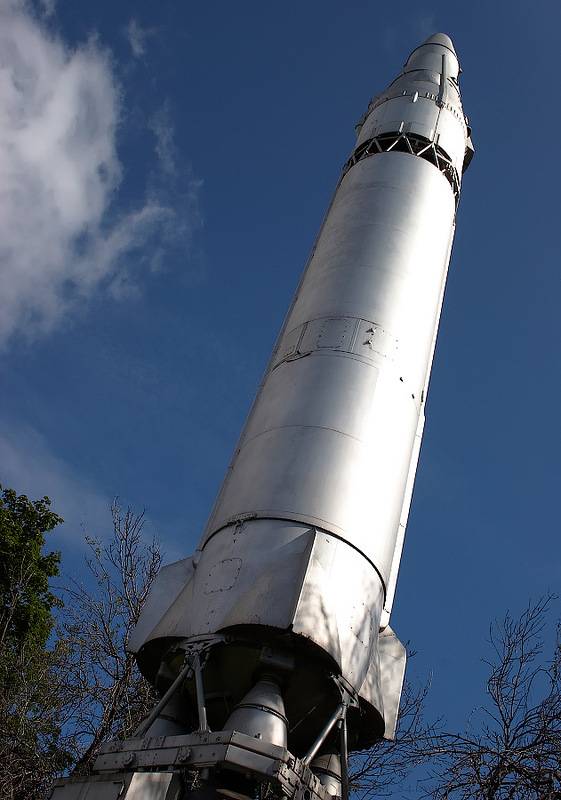
Rocket R-9A on a pedestal at the Central Museum of the Armed Forces in Moscow. Photos from http://an-84.livejournal.com
In the long list of domestic intercontinental ballistic missiles, a special place is occupied by rockets created in OKB-1 under the guidance of legendary designer Sergey Korolev. And all of them share a common property: each at one time was not just a breakthrough in its class, but a real leap into the unknown.
And it was predetermined. On the one hand, the Soviet rocket engineers were unlucky: during the "division" of the German rocket inheritance, the allies got a much more significant part of it. This also applies to documentation and equipment (you can remember how terrifying the crushing state left the factory workshops and rocket platforms left in the Soviet occupation zone), and of course, the German rocket engineers themselves - the designers and engineers. And therefore we had to comprehend a lot of things empirically, making all the same mistakes and getting the same results that the Germans and Americans made and got for several years earlier. On the other hand, this made the creators of the missile industry of the USSR go not trodden paths, but take risks and experiment, deciding on unexpected steps, due to which many results were achieved that were perceived as impossible in the West.
It can be said that in the missile sphere Soviet scientists had their own, special way. But this path had a side effect: the solutions found very often forced the designers to hold on to them until the last. And then paradoxical situations arose: the products, which were based on such solutions, finally reached the present perfection - but by the time when it was obviously outdated. This is exactly what happened with the P-9 rocket, one of the most famous and at the same time unlucky rockets created in the Sergey Korolev design bureau. The first launch of this “product” took place on 9 on April 1961 of the year, three days before the real triumph of the Soviet rocket industry - the first manned flight. And the “nine” has virtually remained forever in the shadow of its more successful and successful female relatives - both royal, Yangelev and chelomee. Meanwhile story its creation is quite remarkable and worth it to tell about it in detail.
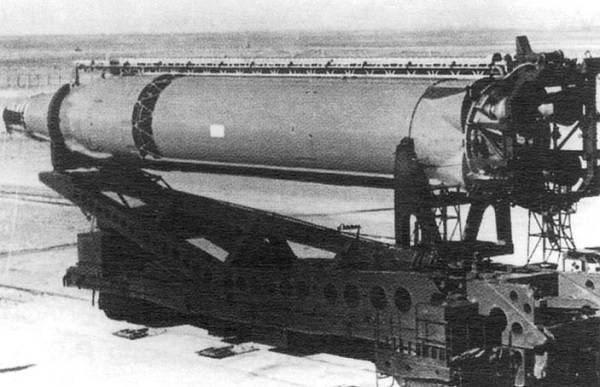
Rocket R-9 on the transport trolley at the site Tyr-Tam (Baikonur). Photo from http://www.energia.ru
Between space and the army
Today it’s no secret for anyone that the famous Vostok carrier rocket, which raised the cosmic heights of the first cosmonaut of the Earth, Yuri Gagarin, and with it the prestige of the Soviet rocket industry, was in fact the conversion version of the R-7 rocket. And the G7 became the world's first intercontinental ballistic missile, and this was clear to everyone since October 4 1957 of the year, since the launch of the first artificial satellite of the Earth. And this championship, apparently, did not give rest to the creator of the P-7 Sergey Korolev and his associates.
Academician Boris Chertok, one of Korolev's closest associates, very openly and self-critically recalled this in his book “Rockets and People”. And the story about the fate of the "nine" can not do without the extensive quotations from these of his memories, since there is little evidence left from those who were directly related to the birth of Р-9. Here are the words with which he begins his story:
“To what extent should the Queen develop combat themes after brilliant victories in space? Why did we create difficulties for ourselves on the path to space that opened up before us, while the burden of building a nuclear missile "sword" could be placed on others?
In the event of the termination of the development of combat missiles, we released design and production facilities to expand the front of space programs. If Korolev had reconciled with the fact that Yangel, Chelomey and Makeyev were enough to create combat missiles, neither Khrushchev, nor even Ustinov, who in December 1957 was appointed deputy chairman of the USSR Council of Ministers and chairman of the military industrial complex, wouldn’t force us to develop new generation of intercontinental missiles.
However, having created the first intercontinental P-7 and its modification P-7А, we could not abandon the gambling race for the delivery of nuclear charges to any part of the world. What happens in the target area, if we throw a real charge with a capacity of one and a half to three megatons there, none of us thought much of it at that time. The implication was that this would never happen.
In our team there were more than enough supporters of work on combat missiles. Disconnection from the combat issue threatened to lose the much-needed support of the Ministry of Defense and the favor of Khrushchev himself. I was also considered a member of the informal party of rocket "hawks", which was headed by Mishin and Okhapkin. The very process of creating combat rockets fascinated us much more than the ultimate goal. The natural process of losing the monopoly on the creation of intercontinental strategic missiles was experienced by us without enthusiasm. Jealousy was caused by the work of our subcontractors with other major ones. ”
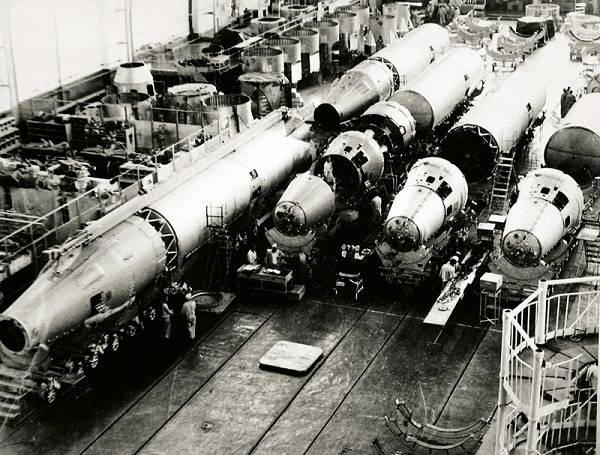
The assembly shop of the P-9 missiles at the Progress plant in Kuibyshev. Photos from http://kollektsiya.ru
P-16 comes on the heels of the Queen
In these very frank words of academician Chertok, alas, some slyness is also hidden. The fact is that space issues alone were not enough to develop successfully and receive government subsidies and support at the highest level. In the most terrible war in its history that the Soviet Union ended a little more than ten years ago, everyone and everything had to work on defense. And the missilemen, first of all, were assigned precisely defense tasks. So, Sergei Korolev simply could not afford to switch from the subject of intercontinental ballistic missiles to exclusively space. Yes, space was also considered as an area of military interests. Yes, almost all manned flights of Soviet cosmonauts (like all others, by the way) had purely military tasks. Yes, almost all Soviet orbital stations were designed as combat ones. But the first and foremost were rockets.
So Sergey Korolev, from whom his deputy Mikhail Yangel had left shortly before, to head his own missile at OKN-586 in Dnepropetrovsk, had every reason to worry about the fate of his team. The difficulties of personal relationships overlap with the danger that the new competitor will become too strong a rival. And it was necessary not to stop, not to stop efforts to create not only space, but also intercontinental ballistic missiles.
“Yangel went to Dnepropetrovsk not to improve the Queen’s oxygen missiles,” writes Boris Chertok. - The rocket P-12 was created there in a very short time. 22 June 1957 of the year in Kapiyar began its flight tests. It was confirmed that the range of the rocket will exceed 2000 km.
The P-12 rocket was launched from a ground-launch device, on which it was installed in an uncharted form with a docked nuclear warhead. The total preparation time for launch was more than three hours. A purely autonomous control system provided a circular probable deviation within 2,3 km. This missile immediately after the launch of the 1959 in March was launched at the plant in a large series and became the main weapon for the Strategic Missile Forces created in December of the 1959 of the year.
But even earlier, in December 1956 of the year, with the direct support of Ustinov, Yangel obtained the issuance of a decree of the Council of Ministers on the creation of a new intercontinental missile P-16 with the start of flight design tests (LCI) in July 1961. The first intercontinental P-7 has never flown, and Khrushchev has already agreed to develop another rocket! Despite the fact that our "seven" was open "green street" and we had no reason to complain about the lack of attention from above, this decision served us as a serious warning. "
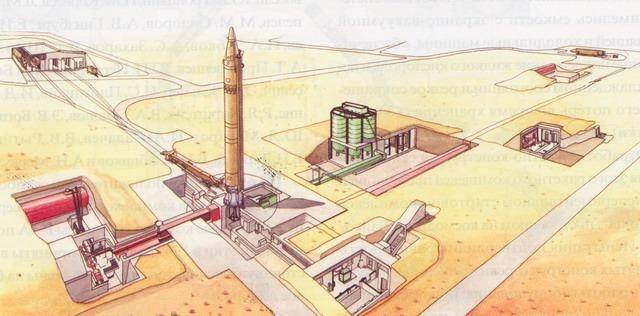
Ground launch complex "Desna N", created specifically for the P-9 missiles. Photo from http://www.arms-expo.ru
Need a long-lived rocket!
The turning point was January 1958 of the year, when a commission was working with might and main to discuss the draft design of the P-16 rocket. This commission, which was headed by Academician Mstislav Keldysh, was collected at the insistence of specialists from the Scientific Research Institute-88, which was actually the same fiefdom of Sergei Korolev as his OKB-1, and where Mikhail Yangel worked until recently. At one of the meetings, the general designer of the new rocket OKB-586, who felt strong support from above, came out with very harsh criticism of Korolev and his commitment to liquid oxygen as the only oxidant for rocket fuel. And judging by the fact that no one broke off the speaker, it was not just the personal position of Yangel. It was impossible not to notice this, and OKB-1 urgently needed to prove that their approach not only has the right to exist, but is the most justified.
To do this, it was necessary to solve the most important problem of oxygen missiles - an unacceptably long preparation time for the launch. Indeed, in the filled state, taking into account the fact that liquefied oxygen at a temperature above minus 180 degrees begins to boil and evaporate intensively, the rocket on such fuel could be stored for tens of hours - that is, a little more than its refueling took! Say, even after two years of intensive flights, recalls Boris Chertok, the preparation time for the P-7 and P-7А for the start could not be reduced more than to the 8-10 hours. And the Yngele R-16 rocket was designed taking into account the use of long-lasting rocket fuel components, which means it could be prepared for launch much faster.
Given all this, OKB-1 designers were required to cope with two tasks. First, significantly reduce the time of preparation for the launch, and secondly, at the same time increase the time that the rocket could be in combat readiness without losing a significant amount of oxygen. And surprisingly, both solutions were found, and by September 1958, the design bureau brought to the conceptual design its proposals for the P-9 oxygen rocket with intercontinental range.
But there was another condition that seriously limited the creators of the new missile in the approaches - the requirement to create a secure start for it. After all, the main drawback of the P-7 as a combat missile was an extremely complex and completely open start. That is why it was possible to create only one combat starting station of the “sevens” (except for the capabilities of the combat launch from Baikonur), having built the Angara object in the Arkhangelsk region. This structure had only four launchers for the P-7A, and immediately after the United States began to use the Atlas and Titan intercontinental ballistic missiles, it turned out to be almost defenseless.
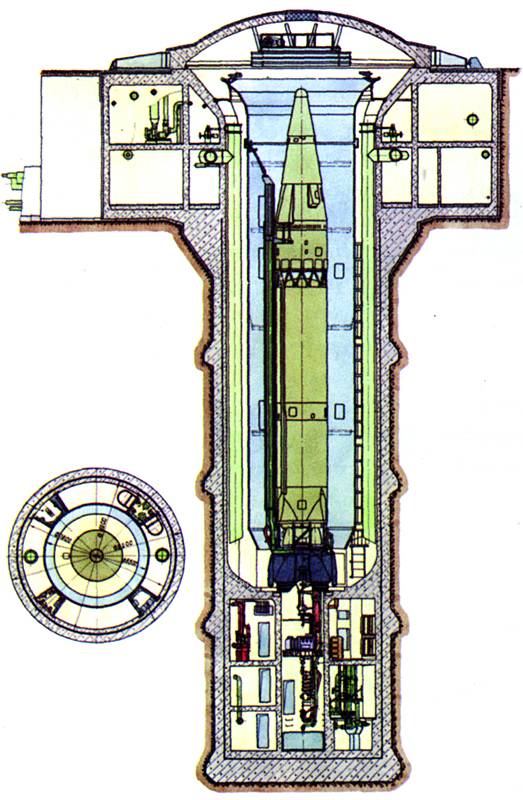
Diagram of the Desna B-type silo launcher developed for the P-9 missiles. Photos from the site http://nevskii-bastion.ru
After all, the main idea of using nuclear missiles weapons in those years, and even many years later, it was to have time to launch your missiles immediately after the enemy launches its intercontinental ballistic missiles - or to secure the possibility of a nuclear strike, even if the enemy’s warheads have already exploded on your land . At the same time, it was considered and considered that one of the priority targets of the strike would certainly be nuclear missile forces and their deployment and launch sites. So, in order to have time to strike back immediately, it was necessary to have excellent quality missile early warning equipment and such a system to prepare the missiles for launch, so that it takes minutes, and even better - seconds. According to the calculations of that time, the attacked side had no more than half an hour to launch its missiles in response to the attack and make the enemy hit the empty launch pads. The second required protected launch sites that could survive a close nuclear explosion.
Angara’s combat starting position didn’t meet either the first or the second, and couldn’t meet because of the peculiarities of the P-7 pre-launch preparation. Therefore, in the eyes of the Soviet leadership, it looked so much quicker to prepare and much more durable Yangelevskaya P-16. And therefore, OKB-1 needed to offer its own missile, not inferior to the "sixteenth" on all counts.
Exit - supercooled fuel!
At the end of 1958, Soviet intelligence obtained information that Americans use liquid oxygen as the oxidizer in their newest intercontinental ballistic missiles, Atlas and Titan. This information has seriously strengthened the position of OKB-1 with its “oxygen” predilections (in the Soviet Union, alas, they did not outlive the practice of looking at the decisions of the likely adversary and following their course). Thus, the initial proposal to create a new oxygen intercontinental ballistic missile P-9 received additional support. Sergei Korolev was able to take advantage of this, and on May 13 of the year 1959 issued a decree of the USSR Council of Ministers to begin work on designing an oxygen-powered Р-9 rocket.
The resolution stipulated that it was necessary to create a rocket with a launch weight of 80 T capable of flying 12 000-13 000 kilometers and at the same time having an accuracy within 10 kilometers subject to using a combined control system (using autonomous and radio subsystems) and 15 kilometers - without her. Flight tests of the rocket, according to the decree, were to begin in the 1961 year.

P-9 rocket launch from the Desna N test site at the Tyr-Tam test site. Photos from the site http://www.energia.ru
It would seem, here it is, the opportunity to break away from competitors from Dnepropetrovsk and prove the advantage of liquid oxygen! But no, above, apparently, they were not going to make life easier for anyone. In the same decree, as Boris Chertok recalls, “in order to accelerate the creation of the R-14 and R-16 missiles, it was prescribed to free OKB-586 from developing missiles for the Naval Fleet (with the transfer of all work to SKB-385, Miass) and stop all work on the subject of S.P. Queen".
And again on the agenda, the question arose of what other ways could be improved, improved future P-9. And then for the first time the idea arose to use not just oxygen, but supercooled oxygen as an oxidizing agent. “At the very beginning of the design it was clear that there could not be an easy life, which we allowed ourselves in the distribution of mass on the G-7,” wrote Boris Chertok. - We needed fundamentally new ideas. As I recall, Mishin was the first to come up with a revolutionary idea about using supercooled liquid oxygen. If instead of minus 183 ° С, close to the boiling point of oxygen, lower its temperature to minus 200 ° С, and even better - to minus 210 ° С, then, firstly, it will take a smaller volume and, secondly, it will sharply decrease evaporation losses. If this temperature can be maintained, it will be possible to carry out a high-speed refueling: oxygen, getting into a warm tank, will not boil violently, as it happens on all our missiles from P-1 to P-7 inclusive. The problem of obtaining, transporting and storing supercooled liquid oxygen turned out to be so serious that it went beyond the purely rocket framework and acquired Mishin at the suggestion, and then the All-Union national economic importance, which the Queen joined in solving these tasks. ”
This is exactly how one of those simple and at the same time very elegant solutions was found that eventually made it possible to create a P-9 rocket, which, with all the advantages of using liquid oxygen as an oxidizing agent for rocket fuel, had all the necessary capabilities for long-term storage and a quick start. Another advantage of the "nine" was the use of the so-called central drive: the rocket control system using the deflection of the main engines. This solution turned out to be so successful and simple that it is still used even on heavy energy-type rockets. And then it was just revolutionary - and greatly simplified the P-9 scheme, and most importantly, eliminated the need to install additional steering engines, which made it easier to weight the rocket.
Продолжение следует ...
Information